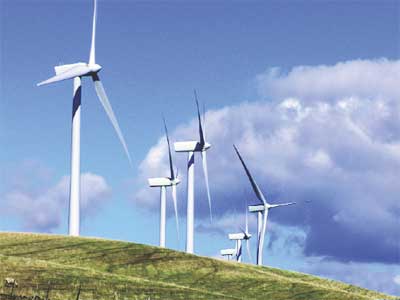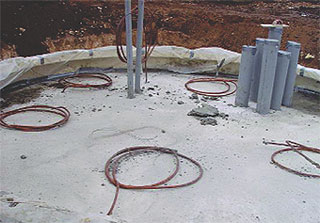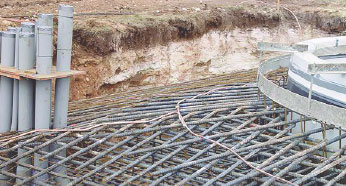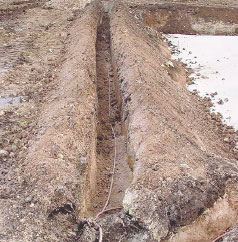![]() Download in PDF format [360 Kb]
Download in PDF format [360 Kb]
- Texas Utility Shows the Way
- Strong Commitment to Alternatives
- Miles of Copper Make It Possible
- Looking to the Future
A technology revolution is quietly taking place in the U.S. electric utility industry. It's green, it's clean, and it doesnt involve imported oil. The fuel is free, and there's a limitless supply of it. Not surprising, then, that megawatts flowing from the technology are growing at more than 20% per year. Were talking about wind energy, of course.

Once seen as an overly expensive alternative energy source, this old/new technology is becoming the hottest buzz in the U.S. energy market. As of 2004, wind only accounted for less than one percent of the nations generating capacity, but thats changing fast. By 2020, according to the American Wind Energy Association, wind is realistically expected to accommodate 6% of our energy needs, or about the same amount we now derive from hydropower. Hitting that target very much depends on consistent Congressional policy support (tax credits are the issue), but theres no doubt that the wind energy industry has gained momentum.
Back to TopTexas Utility Shows the Way
One need only visit a wind-oriented utility to sense the excitement. Historically, the utility industry has adopted new technologies gradually, given the huge amount of capital tied up in generating plants and the time required to license and build facilities. Wind farms, on the other hand, can be designed and erected quickly often in just a few years, start to finish once property issues are settled; and licensing is relatively straightforward compared with conventional or nuclear power plants, owing to wind energys relatively low environmental impact. As a result, a growing number of utilities are making a commitment to renewable energy sources and are adopting wind energy as a major part of their green generating base.
Austin Energy, the municipal utility serving the Texas capital area, is one of the leaders among those companies. In fact, the company has the number one utility-sponsored green power program in the nation for sales, according to the U.S. Department of Energy's National Renewable Energy Laboratory (NREL).
Carol Harwell is Austin Energy's GreenChoice® program manager and product development coordinator for the companys wind energy program. When asked why Austin Energy is promoting wind energy so vigorously, Harwell explains, "Our customers want to preserve the high quality of life they enjoy in Austin, and one way we can help with that is by reducing air emissions through the use of renewable energy. We therefore plan to increase our reliance on renewable energy sources to achieve 20% reliance on them by 2020. Percentage-wise, thats the biggest commitment in the industry. Austin is growing, and, by 2020, our total capacity will have risen to a 4,000-MW peak from the 2,800-MW maximum we can put on line now."
Back to TopStrong Commitment to Alternatives
Wind represents the largest fraction of our renewable base today, says Harwell, and it will continue to be so in the future. "We now have 178 MW of wind capacity, and we hope to add more than 700 MW of renewables by 2020. With our predicted growth rate and rising capacity factors, well be increasing our renewable base from 600,000 MWh/y today to more than three million MWh/y by 2020. We also promote photovoltaic (solar) power with one of the most generous ($4,500 per kW) rebates in the country, and we receive 11 MW of electricity from small onsite methane fueled generators located next to old landfills near Austin and San Antonio."
"But probably our most ambitious plan is to use renewable energy to power plug-in hybrid electric vehicles. Austin Energy is putting together a 50 Cities Plan to build the market for this technology. For our utility, the plan takes advantage of the biggest problem with wind: energy storage. The wind blows more at night, but thats when our demand is the lowest. Theres no way to store that excess energy at a reasonable cost. The plug-in hybrids can be used as energy storage for the extra wind that comes in the middle of the night." Of course, plug-in hybrids have many more benefits.
Austin Energys adoption of wind energy began with a modest 10 MW in 1995. An additional 76.7 MW from the giant King Mountain facility near McCamey, Texas, were brought on line in 2001, and in January 2005, the company signed a multiyear contract for 126 MW from a wind farm near Sweetwater, bringing its total commitment to some 213 MW. Austin Energy doesnt actually own any wind farms. Like a number of other electric utilities, the company secures long-term contracts for a fixed price per MW of power from large wind farms owned by investors or other energy providers.
Mark Kapner, a senior strategy planner in Austin Energy's alternative energy program, points out that municipal utilities are leading the industry in the use of renewable energy. This is so, he believes, because munis can more closely reflect community values. As evidence, he notes that, "Customers must opt to pay a bit more for renewable power under our GreenChoice program" (around seven dollars per 1000 kWh, the monthly usage for an average home), but many are apparently willing to do so. According to NREL, Austin Energys premium is the third lowest in the country.
Variations of green energy pricing are used by many other utilities, although Austin Energy sells more renewable energy than any other program in the USA. Unlike most other utilities, Austin Energy's alternative energy charge replaces the fuel charge on a standard utility bill. And that GreenChoice charge remains fixed for the life of the renewable contracts, typically 10 years. Kapner believes that this arrangement will ultimately benefit the customers pocketbook. "The cost of wind energy has dropped 80% since 1980, and the decline continues as the wind energy industry matures", he says. "By contrast, fossil fuel charges vary considerably over time and are currently rising, so GreenChoice could end up saving the customer money. In addition, the emissions avoided by our program since its inception are equivalent to keeping 50,000 cars off the road. People like that."
Back to TopMiles of Copper Make It Possible
The most important requirement for a wind farm is obviously a sufficient supply of moving air. West Texas has no shortage of that, and as a result, the state ranks second only to California in the amount of wind energy generation capacity (Table 1). Texas also has the necessary elbow room. The area taken up by a large wind farm (Texans prefer to call them wind ranches) can reach 2050 square miles. To minimize aerodynamic interference, individual turbines can be spaced as widely as five to nine rotor diameters apart in the prevailing wind direction and three to five diameters apart in the perpendicular direction, although tighter spacing is commonplace.
| Top Five States (January 2004) | ||
|---|---|---|
| Capacity, MW | Number of Average-sized Homes Able to be Served | |
| California | 2,043 | 600,000 |
| Texas | 1,293 | 387,000 |
| Minnesota | 563 | 168,900 |
| Iowa | 471 | 141,300 |
| Wyoming | 285 | 85,500 |
| Largest Operating Wind Farms (January 2004) | ||
| Stateline, Ore.-Wash. | 300 | 90,000 |
| King Mountain, Tex. | 278 | 83,400 |
| New Mexico Wind Energy Center, N.M. | 204 | 61,200 |
| Storm Lake, Ia. | 193 | 57,900 |
| Colorado Green, Colo. | 162 | 48,600 |
| High Winds, Calif. | 162 | 48,600 |
That's where copper comes in. Ask Brian Evans. He's vice president of RES America Construction, Inc., the Austin-based office of Renewable Energy Systems, Ltd., a global wind energy organization headquartered in Kings Langley, England. RES develops, designs, builds, maintains, and, in some cases operates wind farms in the U.K., Europe, North America, the Caribbean, Australia and Asia. King Mountain is their largest U.S. project to date.
Evans describes his company's current project in Sweetwater1 to illustrate the importance of copper. The project will comprise 61 1.5-MW General Electric turbines, for a total capacity of 91.5 MW. Each turbine will be mounted atop a 130-ft mast, with a copper-wound transformer located 41 ft away from its base. For the 575-V power connections alone, this phase of the Sweetwater project will require 47,500 linear feet of 777-kcmil copper cable.
 Figure 1. Central footing for a wind turbine tower under construction showing six 250-kcmil copper grounding conductors that will be bonded to the steel tower.
Figure 1. Central footing for a wind turbine tower under construction showing six 250-kcmil copper grounding conductors that will be bonded to the steel tower.There will also be a significant quantity of copper control cable on the site. In addition, each tower will be protected by a large grounding system. At Sweetwater, six conductors bonded to the tower (Figure 1) connect to a 250-kcmil copper ring within the base that is, in turn, bonded to rebar in the towers foundation (Figure 2). Copper leads extending outward from that inner ring connect to four, 5/8-in x 8-ft copper-clad grounding electrodes, which in turn are bonded to a copper ground ring that completely encircles the pad (Figure 3). Ground rings at all turbines are connected to all others to form a single, networked grounding system for the entire facility having an aggregate resistance of less than 1.5 Ω . The grounding system and neutral conductors, together, use 30,000 linear feet of 250-kcmil copper cable.
 Figure 2. A ring of 250-kcmil copper is bonded to rebar in the footing skirt. The ring connects the conductors shown here with the ground ring shown in Figure 3.
Figure 2. A ring of 250-kcmil copper is bonded to rebar in the footing skirt. The ring connects the conductors shown here with the ground ring shown in Figure 3. Figure 3. The footing skirt is encircled by a 250-kcmil copper ground ring, which, in turn, is bonded to four 8-ft copper-clad electrodes (foreground). Ground rings for all turbines are connected, again using 250-kcmil copper, thus establishing a uniform ‹1.5-Ω ground potential for the entire wind farm.
Figure 3. The footing skirt is encircled by a 250-kcmil copper ground ring, which, in turn, is bonded to four 8-ft copper-clad electrodes (foreground). Ground rings for all turbines are connected, again using 250-kcmil copper, thus establishing a uniform ‹1.5-Ω ground potential for the entire wind farm."Conductors connected to the 34.5-kV secondaries from the towers' transformers are joined at several junction boxes located around the site," says Evans. "To connect the towers into groups in this fashion, we used 110,000 linear feet of AWG 2/0 copper."
"The groups of turbines feed two substations located on the facility. Two all-copper transformers at each substation step up the voltage in stages from 34.5 kV to 138 kV and from 138 kV to 345 kV, respectively, to connect to the utility grid. The high-voltage cables include 229,000 linear feet of AWG 3/0, 50,000 feet of 350 kcmil, 18,000 feet of 750 kcmil, 30,000-feet of 1000 kcmil and 29,000 feet of 1,250 kcmil. In this particular location, the high-voltage cables have aluminum phase conductors, but their concentric neutral conductors are copper."
Not counting the turbines, transformers and control wires, the Sweetwater II wind farm contains more than 35 miles of copper low-voltage and grounding cable and more than 67 miles of copper in the neutral conductors of highvoltage power cable.
Back to TopLooking to the Future
The trend to increased consumption of wind energy is clearly upward. Latest worldwide data indicate that nearly 40,000 MW of capacity had been installed by the end of 2003, a figure which was increasing by at least 9% per year (Figure 4).
 Figure 4. Recent Global Growth in Wind Energy Use (Source: AWEA).
Figure 4. Recent Global Growth in Wind Energy Use (Source: AWEA).The USA is only one of many countries now actively adopting alternative energy sources. Commercial-scale use of wind energy is better known overseas, with Germany and Spain leading the field. Denmark, which receives plenty of wind from the North Sea, is also a major wind-energy player. The tiny country is working to convert 40% of its national energy use to wind by 2030, and, in so doing, has become one of the worlds leading suppliers of wind technology and equipment.
American companies are quickly joining the parade, offering new, high-efficiency turbines, advanced structural materials, computerized control equipment and aerodynamic design improvements. One U.S. company (GE) is strongly increasing its share of the wind turbine market and now commands more than one-half of all new installations in the country.2 The large offshore technology base that made the Gulf of Mexico a major petroleum resource might, in the near future, give rise to platform-based wind farms off several U.S. coastlines. Turbines located offshore tend to be larger than land-based installations, and models ranging up to 3 MW are under development.3
| Top five wind energy markets (installed capacity, in MW) | 2002 Additions | 2002 End Year Total | 2003 Additions | 2003 End Year Total |
|---|---|---|---|---|
| Germany | 3,247 | 12,001 | 2,645 | 14,646 |
| United States | 410 | 4,685 | 1,687 | 6,372 |
| Spain | 1,493 | 4,830 | 1,377 | 6,207 |
| Denmark | 407 | 2,880 | 243 | 3,123 |
| India | 195 | 1,702 | 408 | 2,110 |
How will the USA satisfy its growing energy needs without endangering the environment and raising its dependence on foreign sources? It appears that at least one answer is written on the wind.
Back to TopThe Principals
 Carol Harwell came to Austin Energy in 2000 as a product development coordinator for renewable energy and energy-efficiency products. Currently, she manages GreenChoice®, the utility's renewable energy subscription program. Ms. Harwell can be reached at (512) 322-6562 and at carol.harwell@austinenergy.com.
Carol Harwell came to Austin Energy in 2000 as a product development coordinator for renewable energy and energy-efficiency products. Currently, she manages GreenChoice®, the utility's renewable energy subscription program. Ms. Harwell can be reached at (512) 322-6562 and at carol.harwell@austinenergy.com. Mark Kapner is a senior strategy planner for Austin Energy and a key individual in his company's program to increase alternative energy use dramatically. Mr. Kapner can be reached at (512) 322-6123, mark.kapner@austinenergy.com.
Mark Kapner is a senior strategy planner for Austin Energy and a key individual in his company's program to increase alternative energy use dramatically. Mr. Kapner can be reached at (512) 322-6123, mark.kapner@austinenergy.com. Brian Evans is vice president of RES America Construction Inc. Mr. Evans leads a group of designers, engineers and analysts responsible for the development of wind farms in Texas and elsewhere in the USA. Mr. Evans can be reached at (512) 708-1538, Brian.Evans@res-americas.com.
Brian Evans is vice president of RES America Construction Inc. Mr. Evans leads a group of designers, engineers and analysts responsible for the development of wind farms in Texas and elsewhere in the USA. Mr. Evans can be reached at (512) 708-1538, Brian.Evans@res-americas.com.
Footnotes
 RES is developing the Sweetwater II project in conjunction with Babcock & Brown and Catamount Energy. The company did not participate in an earlier phase, Sweetwater I, of what is eventually expected to become a 400-MW wind farm. RES developed the King Mountain facility together with FPL Energy and Cielo Wind Power.
RES is developing the Sweetwater II project in conjunction with Babcock & Brown and Catamount Energy. The company did not participate in an earlier phase, Sweetwater I, of what is eventually expected to become a 400-MW wind farm. RES developed the King Mountain facility together with FPL Energy and Cielo Wind Power. American Wind Energy Association, Global Wind Energy Market Report (latest reports can be found on the AWEA site).
American Wind Energy Association, Global Wind Energy Market Report (latest reports can be found on the AWEA site). Utility-scale wind turbines in service in the USA commonly range between 1.5 and 1.8 MW in size. Prototype turbines ranging up to 2.5 MW have been under test in Europe for several years, and a 3.6-MW unit has been built by the General Electric Company for testing by the U.S. Department of Energy. See Danish Wind Industry Association and U.S. Department of Energy for further information.
Utility-scale wind turbines in service in the USA commonly range between 1.5 and 1.8 MW in size. Prototype turbines ranging up to 2.5 MW have been under test in Europe for several years, and a 3.6-MW unit has been built by the General Electric Company for testing by the U.S. Department of Energy. See Danish Wind Industry Association and U.S. Department of Energy for further information.
